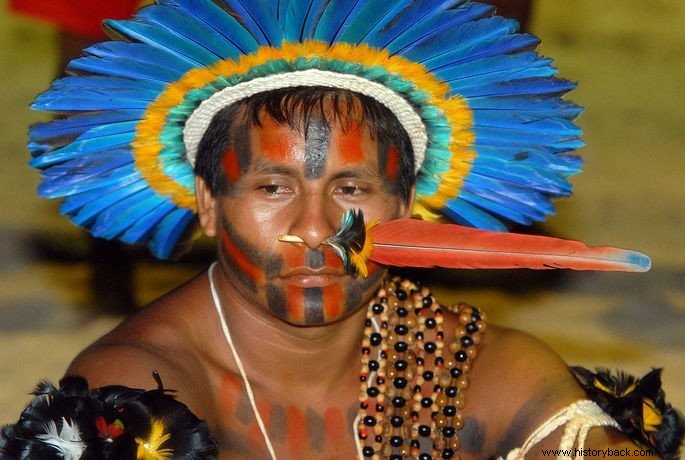The indigenous culture encompasses the material and immaterial production of countless different peoples throughout Brazil.
It is important to point out that there is not one indigenous culture, but several, and each people has developed its own religious, musical, festival and handicraft traditions, among others.
Customs of indigenous populations
The different indigenous populations have different customs. But in power , many stand out for the production of cassava, from which they produce beiju, and also the production of corn, with which they make pamonha.
Build housing of wood and straw called “hollows”, where one or more families can live. Generally, the warrior leader is the cacique, while the spiritual leader is the shaman.
The main indigenous tribes currently in Brazil are:Guarani, Ticuna, Caingangue, Macuxi, Terna, Guajajaras, Yanomami, Xavante, Pataxó and Potiguara.
Indigenous Religion
From a religious point of view, indigenous cultures are marked by the presence of the shaman (shaman), responsible for mediating between the spiritual and material planes, as well as for the preservation and dissemination of the tribe's knowledge.
In their rituals, usually pantheists (who believe that nature and the divine are connected), they revere the ancestors, the elements, plants, animals and mythological beings.
Another curious fact is the use of substances in their rituals, such as tobacco, used to connect with the spiritual world.
Another interesting aspect is the indigenous perception of Time and the Universe, for which there is no well-defined linearity.
Indigenous Arts and Crafts
The objects produced by indigenous cultures, despite their evident aesthetic value, are not considered “art” by their producers, as they are for everyday or ritual use, as well as for exchange with neighboring peoples.
Among them, the importance of music, dance, feather art, basketry, ceramics, weaving and body painting stands out.
The music It is used on special occasions such as war rites, planting and harvesting festivals and initiation rites.
The indigenous culture uses music as a way to tell their stories and gives it magical powers, with which they are able to affect the cosmological order.
Likewise, the dance It has similar functions to music in indigenous societies. Usually, the dances are of the circular type, in order to obtain bountiful harvests, scare away evil spirits, cure diseases, etc.
On the other hand, feather art it has more decorative functions (headdresses and bracelets) and, as a rule, is restricted to men.

While the basketry and the ceramics are practiced more by women. They make use of various braids to make baskets for different purposes and use clay to obtain vessels, pots, ritual objects, adornments, among others.
Women are also responsible for the production of fabric (usually cotton), but the clothes made vary according to the climate or are non-existent.
Finally, both sexes practice body painting , usually with abstract and geometric designs, loaded with symbologies (war, protection, etc.). This type of paint can also be found on animals, utensils, trees and rocks.
Read:Brazilian Indigenous Art, Indigenous Dances and Feather Art.
Material Culture of Indigenous Peoples
Some tools, weapons, ornaments and, often, dwellings for nomadic hunter-gatherer peoples are part of the material culture of various indigenous peoples. These peoples practice fishing and subsistence agriculture and move periodically, according to seasonality and the availability of natural resources.
In the material culture of many, feather art and body painting stand out, and fabrics for clothing are rare.
Indigenous History
Roughly speaking, indigenous populations are made up of people originating in Brazilian territory. They were already present in the country when the Portuguese arrived here.
Thus, they were cruelly dominated and enslaved during the pre-colonial and colonial period. Even so, even with the systematic cultural erasure by the Europeans, some peoples preserved, in many cases, their historical and social continuity until the present day.
In Brazil, indigenous tribes are hunter-gatherers of oral tradition and many are located today in indigenous reserves.
However, with the advance of deforestation and illegal mining activities, even the reverse ones are threatened.
To learn more, read:Indigenous Slavery in Colonial Brazil.
Indigenous Social Structure
In general, indigenous societies are structured without private property and have collective housing. They are still egalitarian, politically decentralized and with different social status according to the division of labor.
It is not possible to generalize, as they are different peoples, but in many tribes men are responsible for the construction of the village, war, hunting and fishing, tribal leadership and shamanic rituals. Meanwhile, the women handle the planting and harvesting, preparing the food and producing fabrics, ornaments and utensils.
The education of children is generally shared by all.
Indigenous cultures are, as a rule, based on orality. However, even in the absence of writing, a variety of signs and other graphic forms fulfill the communicative role.
Tribes tend to maintain ties of kinship and reciprocity among themselves, in monogamous or polygamous families. Despite this, leadership is not hereditary.
See also:Formation of the Brazilian People:history and miscegenationTo learn more :
- Tupi-Guarani Culture
- Rio Grande do Sul
- Brazilian Folklore
- Ethnocentrism
